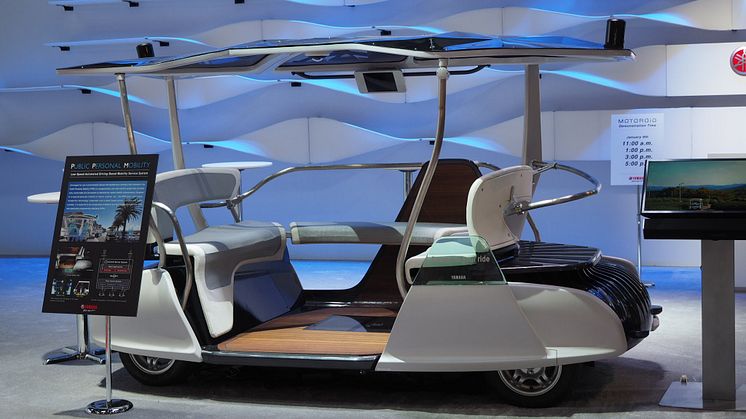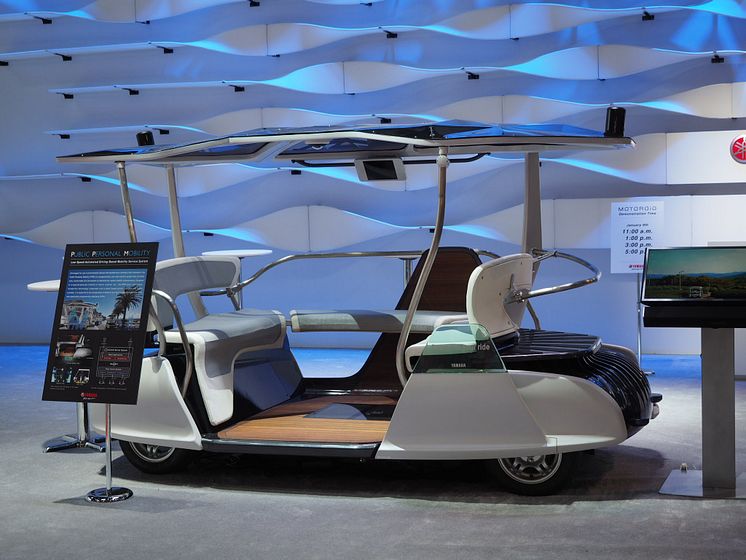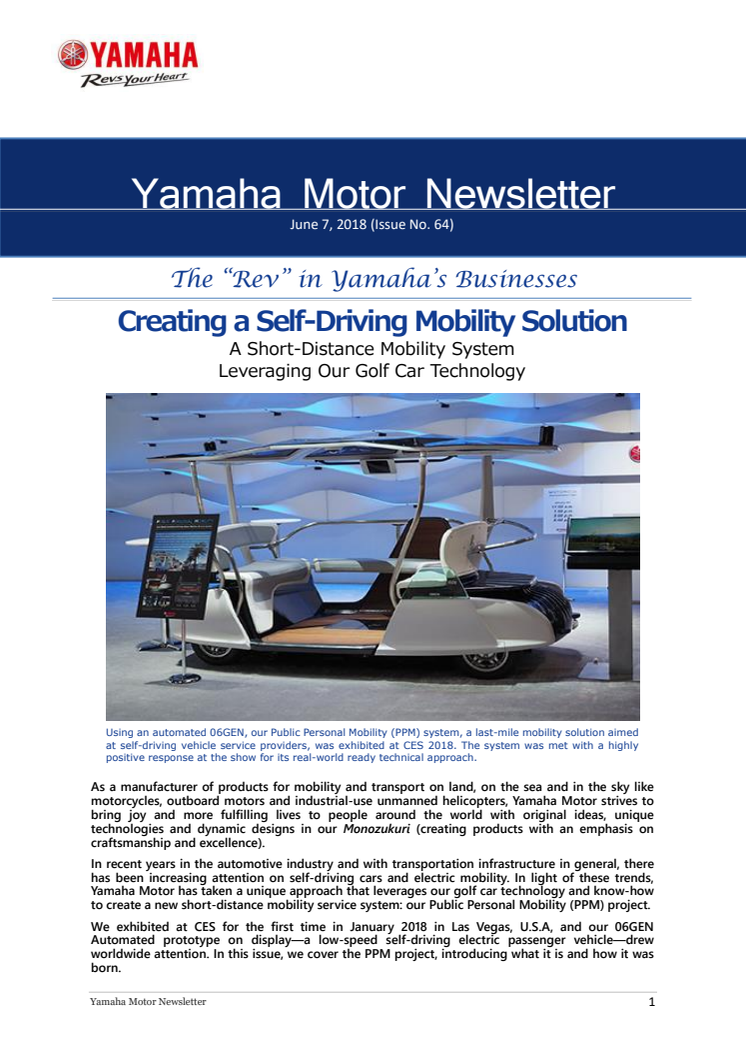
News -
Creating a Self-Driving Mobility Solution Yamaha Motor Newsletter (June 7, 2018 No. 64)
As a manufacturer of products for mobility and transport on land, on the sea and in the sky like motorcycles, outboard motors and industrial-use unmanned helicopters, Yamaha Motor strives to bring joy and more fulfilling lives to people around the world with original ideas, unique technologies and dynamic designs in our Monozukuri (creating products with an emphasis on craftsmanship and excellence).
In recent years in the automotive industry and with transportation infrastructure in general, there has been increasing attention on self-driving cars and electric mobility. In light of these trends, Yamaha Motor has taken a unique approach that leverages our golf car technology and know-how to create a new short-distance mobility service system: our Public Personal Mobility (PPM) project.
We exhibited at CES for the first time in January 2018 in Las Vegas, U.S.A, and our 06GEN Automated prototype on display—a low-speed self-driving electric passenger vehicle—drew worldwide attention. In this issue, we cover the PPM project, introducing what it is and how it was born.
Self-Driving Technology: Seeking Solutions for Short-Distance Mobility
On a street in a popular tourist destination, I bring up the Yamaha Public Personal Mobility app on my smartphone and tap the call button. In a few minutes, an unmanned golf car designed to carry four to five passengers pulls up and stops beside us. My family gets on board and I select our destination on the tablet next to my seat. The rest is all up to the vehicle. As we take in the buildings lining the streets and the local scenery, we listen to the bits of info from the onboard audio tour guide, chit-chat and take pictures and videos. Before long, we arrive at the restaurant I had made a lunch reservation for.
This is but one example of the kind of use and services the Public Personal Mobility (PPM) system and 06GEN Automated prototype Yamaha exhibited at CES 2018 could possibly provide on city streets.
It was about 20 years ago that Yamaha first envisioned using our golf cars to make short-distance transportation in tourist areas, suburban residential communities and the like smoother, more compact and more convenient for people. That set a number of development projects and tests in motion to explore possible methods of use, results and the implementation issues involved.
Today, the PPM project is carried out primarily by the EM Development Section at Yamaha Motor’s Mobility Technology Center. Carrying on past R&D work, their efforts focus on the consideration of and planning for a variety of different mobility services and developing not only the necessary vehicles and their equipment, but also their management and operating systems.
The 06GEN Automated is one prototype born of their work. It utilizes the Virtual Guide Line (VGL) system that employs a camera fitted to the bottom of the vehicle to capture images of the road and then compare it in real-time with the data stored in a pre-recorded map database (image matching), thereby allowing the vehicle to acquire highly accurate information about its own positioning and orientation. It also has a 3D LIDAR scanning system that will slow or stop the vehicle if it detects an obstacle in the path ahead. These two technologies enable its high-precision self-driving capability.
What’s more, a combination of cloud-based control servers, a web-based API and more allow for the creation of mobility service systems adaptable for a wide range of environments and uses at a low cost. This practicality and real-world ready approach made Yamaha’s PPM proposal the center of attention from visitors and the media at CES 2018.
 The 06GEN Automated uses image recognition via a camera fitted to the bottom of the vehicle to determine its current position.
The 06GEN Automated uses image recognition via a camera fitted to the bottom of the vehicle to determine its current position.
Yamaha Golf Cars: A Solid Self-Driving Record and Suitable for Commuter Use
Yamaha Motor began manufacturing and selling golf cars in 1975. They became popular for their hard-working gasoline engines, after which Yamaha launched its first electric model. Then in 1996, a model with an electromagnetic guidance system allowing it to automatically run along a preset course was added to the lineup. Yamaha worked to further expand the range of its golf car business by introducing this specially outfitted model at recreational facilities and large parks.
With this electromagnetic guidance system, self-driving is made possible by the electric wire and magnets installed along the course to be run; the car’s electromagnetic sensor reads the changes in the magnetic field and operates the steering and controls to automatically keep the vehicle on course and stop it at the desired places. Speed adjustments are also performed automatically via a speed sensor, so all passengers have to do is push the start button when they are ready to go. Very simple operation and high reliability are the hallmarks of the system, and its use is spreading in Japan, primarily on golf courses.
Meanwhile, the group of Yamaha engineers working on developing vehicles for short-distance mobility at sightseeing areas and suburban residential communities had turned their attention to golf cars, since they were already well suited for short-range transportation. They could readily be designed with low floors to make getting on and off easier for the elderly and people with disabilities, with open-air cabins for visibility in all directions, with eco-friendly and inexpensive electric motors providing enough performance for speeds around 20 km/h and with self-driving capability with the electromagnetic guidance system. Working together with other business units that wanted to expand their fields of operation, the group continued their efforts and planned and proposed new mobility systems.
For example, Yamaha received a request from the 2002 Floriade international horticultural exposition in the Netherlands for a mobility service to transport visitors to the various viewing points around the venue. For this, Yamaha prepared and supplied a special 5-seat cart (no driver’s seat) based on a golf car with an electromagnetic guidance system. At the expo, some 400,000 visitors in all used 25 of these carts running automatically on a dedicated 1.5 km course people could not step into.
 At the Floriade 2002 international horticultural expo in the Netherlands, Yamaha golf cars were used for a self-driven shuttle service at the venue.
At the Floriade 2002 international horticultural expo in the Netherlands, Yamaha golf cars were used for a self-driven shuttle service at the venue.
“After that, we worked with a research lab at the University of Tokyo for some field tests,” recalls the Senior General Manager of the EM Development Section. “We set up a looped course about half a kilometer long on the central walkway in a large-scale condo complex in Kashiwa, Chiba Prefecture. We had three ‘stations’ for two self-driving shuttles and had interested passersby experience calling a shuttle, selecting a station and being driven to it. We had our support staff always near each shuttle, and while the vehicle moved at a walking pace, it was moving among other pedestrians and people riding bicycles on the path, so we were able to get a lot of very valuable data about running such an operation.”
Since then, however, Japan has been beset with a low birthrate, a rapidly aging society and tighter municipal budgets that have forced the closures of unsustainable train and bus lines, burdening people that rely on public transportation for daily errands like shopping or hospital visits. Also, a growing number of communities blessed with several tourist attractions have been experiencing a sharp drop in the number of visitors due to the lack of convenient public transportation.
As an answer to these kinds of problems, the local Chamber of Commerce in the famous lacquerware town of Wajima in Ishikawa Prefecture proposed a new public transportation system they called “EcoCart” to provide electric passenger carts to round designated routes catering to both residents and tourists, and they began their own field testing with manually driven golf cars.
Yamaha cooperated in this project and official permission was granted in 2014 to certify these golf cars as compact (kei) vehicles for use on public roads. Yamaha then began conducting self-driving tests using golf cars equipped with the electromagnetic guidance system, representing a big step toward eventual use of these vehicles as part of a public transportation system.
Reliability: Refining the Hardware and Software
The testing in Wajima was widely covered by the Japanese media, and with self-driving vehicle systems becoming a more prominent topic in the automotive industry worldwide, the Japanese government established the Conference for Public-Private Collaboration in Automated Driving Systems.
This led to the start of two projects, primarily by the Ministry of Land, Infrastructure, Transport and Tourism and the Ministry of Economy, Trade and Industry. One of these is to begin field tests toward implementing short-
distance mobility systems for people living in remote areas or people without adequate means of transportation, using self-driven vehicles along predetermined routes to better connect these people to their local facilities and provide links to the main bus or train lines. The other project is field tests for providing transportation and delivery services for residents in remote mountain areas, where the aging of society is particularly acute, using self-driven vehicles based at
Michi-no-Eki roadside rest areas.
 Yamaha’s compact, low-speed electric vehicle is being used in Japan’s first field tests on public roads of a remote-controlled self-driving vehicle service.
Yamaha’s compact, low-speed electric vehicle is being used in Japan’s first field tests on public roads of a remote-controlled self-driving vehicle service.
While the major automakers are not participating in these projects, Yamaha Motor is providing two different specifications of golf car-based self-driven vehicles fitted with electromagnetic guidance systems at the request of the two projects, and we are receiving feedback from the tests.
“What we’re aiming for is to become a system supplier. Instead of just running a short-range mobility service, we want to offer a package deal of self-driven electric vehicles as well as the software for managing and running them,” says the EM Development Section Senior General Manager. “It’s not a large-scale system like what automakers are working on, but one focused on the people and oriented to the lives they’re living, thus making it practical and affordable even for local governments to implement. “Our electric golf cars and electromagnetic guidance system have the performance and functionality just right for a low-cost short-distance transportation service, and the Virtual Guide Line (VGL) system on the 06GEN Automated makes it simpler to alter the drive route or add new routes. The 06GEN Automated also uses a 3D LIDAR scanner to detect pedestrians or obstacles on the road, but the test vehicle we’re using for the Michi-no-Eki project also features proprietary Yamaha imaging technology using stereo cameras.
“A big issue going forward is to ensure these vehicles have the reliability to make them a viable part of the public transportation system. Unlike an enclosed facility like a golf course, there are numerous unpredictable factors that come into play, like pedestrians and other vehicles, the surrounding environment like the weather, climate and topography, and new factors that appear over time. Toward that end, the repeated field testing we’re doing and the data we get from it is how we’re looking for possible technological solutions for these factors,” concludes the Senior General Manager.
And the final step is to build up a portfolio of reliable technology that will enable us to provide ideal mobility solutions that fit the particular environment of a community or meet the requests of service operators. Yamaha’s PPM project will continue to steadily move forward, step by step toward the realization of this goal.
PPM Features and Highlight Video (YouTube)
Read more about Yamaha’s low-speed automated driving mobility-based service system on our technology website.
|
Message from the Editor As someone who loves golf, I’ve used golf cars for a long time at courses in Japan and abroad, and I thought that I knew them well, but I honestly never imagined that they would someday be used for self-driving vehicles in towns. The idea of self-driving vehicles usually brings to mind the large-scale efforts being undertaken by the major automakers, so I was surprised to learn that our company has already established the key technologies to make the next form of self-driven transportation possible for society! There’s nothing flashy about this technology, but it’s definitely on the right course for real-world implementation. Naoto Horie |



